- Local Time: 07:58 AM
- Weather: 22 ℃ / 72 ℉
Siwa Oasis, located between Egypt’s Western Desert and the Libyan border, is a captivating destination rich in natural beauty, ancient history, and Berber culture. This guide explores iconic landmarks like the Temple of the Oracle, Mountain of the Dead, Cleopatra’s Spring, and the Great Sand Sea. It also highlights Siwa’s unique geology, wildlife, and eco-lodges, alongside practical travel tips on weather, safety, and accommodations—offering an immersive escape for curious travelers.
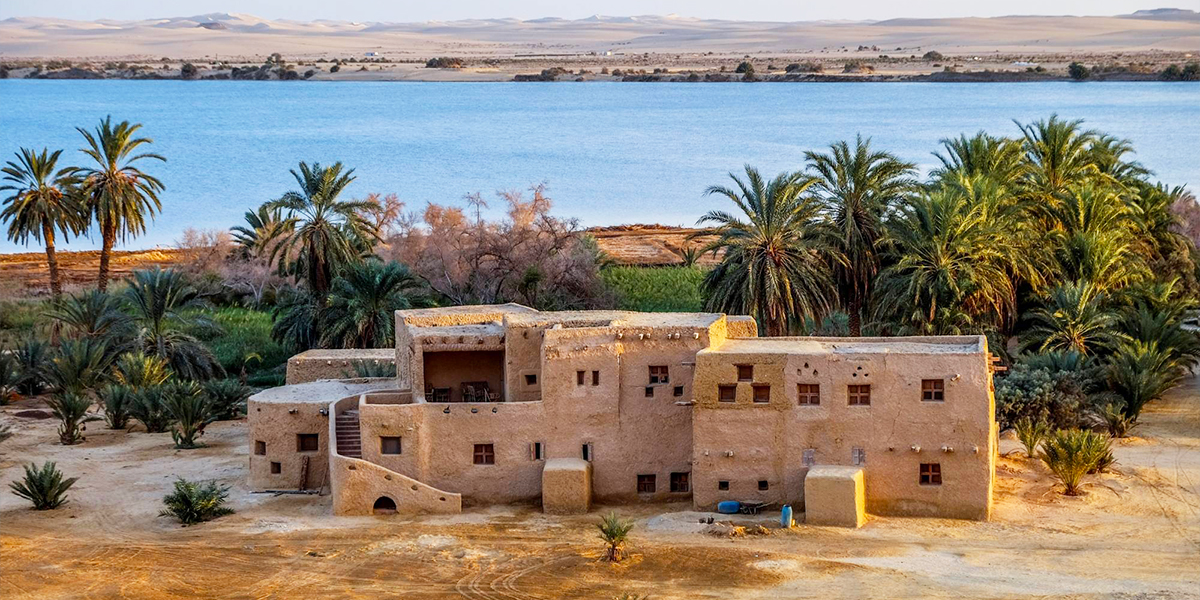
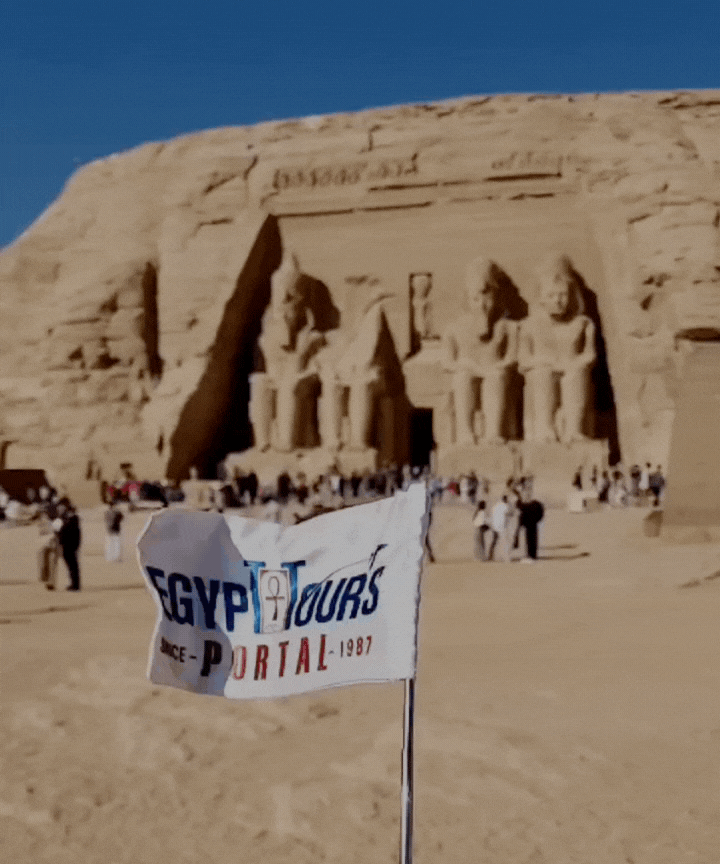
Siwa Oasis is a magical land of beauty filled with natural living entities as old and classy as time. The goal of this article is to offer every traveler all the facts and information about Siwa Oasis. This article was written by a group of a very knowledgeable and professional team of tour operators, tour guides, and travel consultants who will shed some light on Siwa Oasis. One of the most beautiful hidden places in Egypt is the Siwa Oasis, as it is famous for being a piece of heaven, a green spot in the desert of the Sahara sand.
Siwa Oasis is totally worth visiting, filled with a mixture of hot and cold springs, major sand dunes, enchanting history, and marvelous culture. All the local inhabitants of Siwa actually speak their own language, which is similar to the Zenata language, which is more like the language spoken by the Berber than the Egyptian Arabic spoken in the rest of Egypt. The geographical location, ecosystem, and inaccessibility of Siwa have created a special and rare society separate from mainstream Egyptian culture.
Siwa Oasis in Egypt is very ancient and extremely enchanting with its own history and culture. Within the Oasis, A human footprint was found that is thought to date back three million years, making it one of the oldest human prints in history.
The name Oasis is an ancient Egyptian word for palm land, and it was passed down to the Berber tribe and to the Asian (Falcon), a type of prey bird that was one of Amun-Ra's Symbols, which explains how the city gained the name Oasis of Amun Ra. It also gained quite fame in 331 BC during ancient times as the home of the Oracle of Ammon, whom Alexander the Great sought for her counsel.

The Siwa Oasis can be traced back to 10,000 BC, showcasing the earliest signs of civilization, and in the 26th dynasty, around 525 BC, the first signs of human existence in the oasis of Siwa were noticed. It became ancient Greeks made contact with the Siwa oasis in the 7th century BC, plus the place served as the home of the oracle temple of Amun, which was visited by Alexander the Great while hunting wild birds across the desert. The Oasis was known as the Oasis of Amun-RA.
During the Ptolemaic kingdom, the ancient Egyptians called the Siwa oasis the Fields of Trees was also called in ancient Egypt as the field of trees and by the famous historian Herodotus as the foundation of the sun. In the 12th century, it was known to be the official home of the Berber. It was once the home for the entire population in a 13th-century mud-brick fortress called Shali until it was destroyed by a rainstorm in 1926.
It is an urban Oasis in Egypt between the great sand sea of the western desert and the Qattara Depression, about 50 km (30 mi) east of the Libyan border and 560 km (348 mi) from Cairo. The journey from Cairo takes about 8 hours by car.
Siwa is one of Egypt's most isolated areas with a population of 33,000 people, mostly Berber who have their own language called Siwi. It is a deep depression that reaches about 19 m (60 ft) below sea level. It is about 8 hours by car and longer by overnight bus.
Explore the marvelous beauty and unique history of the grand oases of Egypt
Read More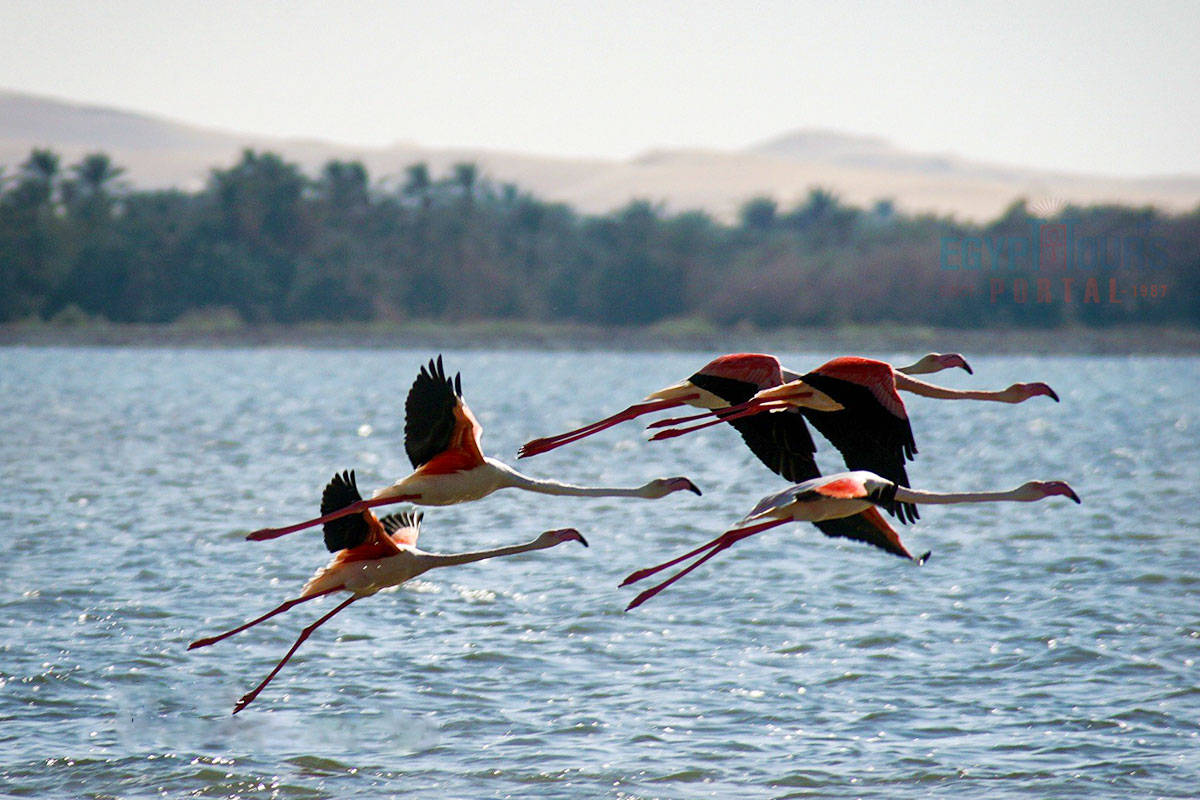
Siwa Oasis is filled with olive and palm trees, crystal-clear springs scattered all over the oasis, which offer a heavenly break from the harsh heat. There are many lakes and thousands of springs, but the saltwater offers little agriculture, as there are more than 300 freshwater springs and streams, shaded by an estimated 300,000 palm trees and 70,000 olive trees.
There are some birds like turtle dove and Streptopelia, and endangered species like Slender-horned Gazelle and Fennec Fox. The Oasis is also a natural habitat for the Cheetah, one of the most threatened cats in the world.
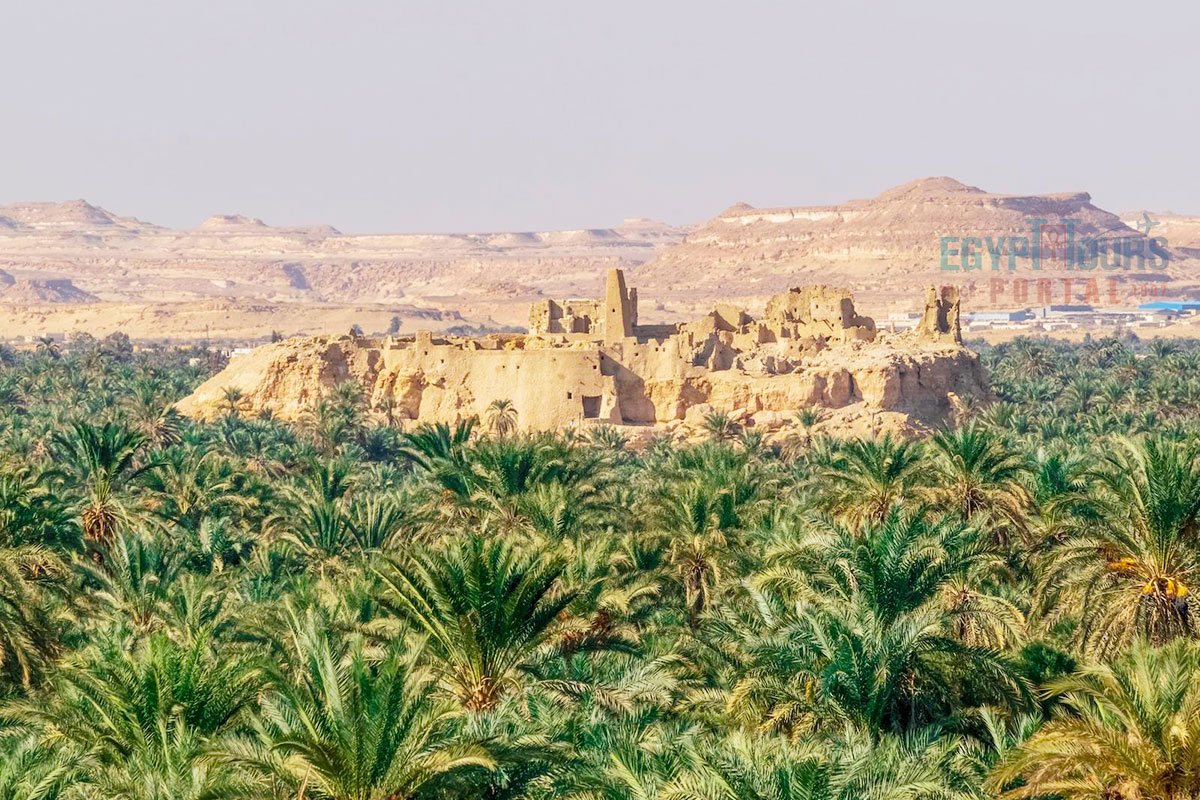
One of the most famous landmarks in Siwa Oasis is the temple of the oracle, which dates to the 6th century BC. It was constructed by Alexander the Great, who asked her about his fate and whether he was the son of Zeus, and it is believed he was buried in Siwa.
Near the town center is the mountain of death that holds more than 1500 tombs dating back to the late pharaonic and Greco-Roman periods. The tombs showcase incredibly beautiful and ornate funerary drawings.

Siwa Oasis is one of the most beautiful, mysterious, and enchanting of all Egypt’s oases. Siwa Oasis is filled with a variety of things to do, places to visit, and unique attractions, such as:
Shali is an attractive tourist attraction, where visitors can climb up a melted mound of mud and salt, which is the traditional Siwan construction material used in the 13th century. Every traveler will have a glimpse of the view of date and olive groves that stretch out for endless meters in each direction of the Siwa Oasis.
Cleopatra’s Bath, of Cleopatra’s pool, is located on the route leading to the Oracle temple. Cleopatra’s Spring is a natural spring water stone pool where tourists can enjoy the health benefits of a spring bath in the town of Siwa. Some believe that the spring belonged to Queen Cleopatra VIII herself. Being one of the most beautiful and best natural pools in Egypt, that's why it gets a lot of locals to bathe and visit the pool. it’s advised to wear appropriate swimming clothes to avoid any attention.
The Salt Lakes are one of the most beautiful scenes in Siwa, filled with clean and transparent green plant life. The Salt Lakes are very magical,l which attracts people all year long because of their health benefits due to the high concentration of salt. Floating and swimming in the Salt Lakes of Siwa is a very marvelous and majestic experience.
Siwa was popular for the Temple of the Oracle, which dates from the 6th century BC and was very famous throughout the Mediterranean region. Alexander the Great came to Siwa to consult with the oracle about his fate, whether he was the son of Zeus or not. Some believe that Alexander requested that his generals bury him in Siwa. The ruins of thereat temple of the Oracle are still open to visitors to this day.
Close to the center of Siwa is the Mountain of the Dead, which is a rocky hill filled with more than 1500 tombs that date back to the late pharaonic period. Some of the tombs date back to the Greco-Roman Period as they are decorated with enchanting and ornate funerary drawings.
Fantas Island is located on the edge of the oasis on the shore of Lake Siwa, about 6 kilometers from the center of the oasis. The hot spring offers the chance to swim and enjoy the health benefits of the healing waters, plus all the marvelous cafés and restaurants found across the lake at the moment of sunset.
The Great Sand Sea is at the front of the Siwa Oasis, offering the beautiful scenery of sand in the shape of mountains found across the endless desert. A super safari tour is a marvelous chance to explore the beautiful springs and rock formations within these vast and heavenly sites.
The Siwa House Museum is a magical place filled with heavenly art and history. The Museum is filled with real artifacts belonging to the ancient Siwa population, which provide a deep look at ancient Siwan traditions and local customs, such as the traditions of Siwa’s wedding, which is known to last for 7 days, where the bride wears a special outfit that can be found inside the Siwa House Museum.
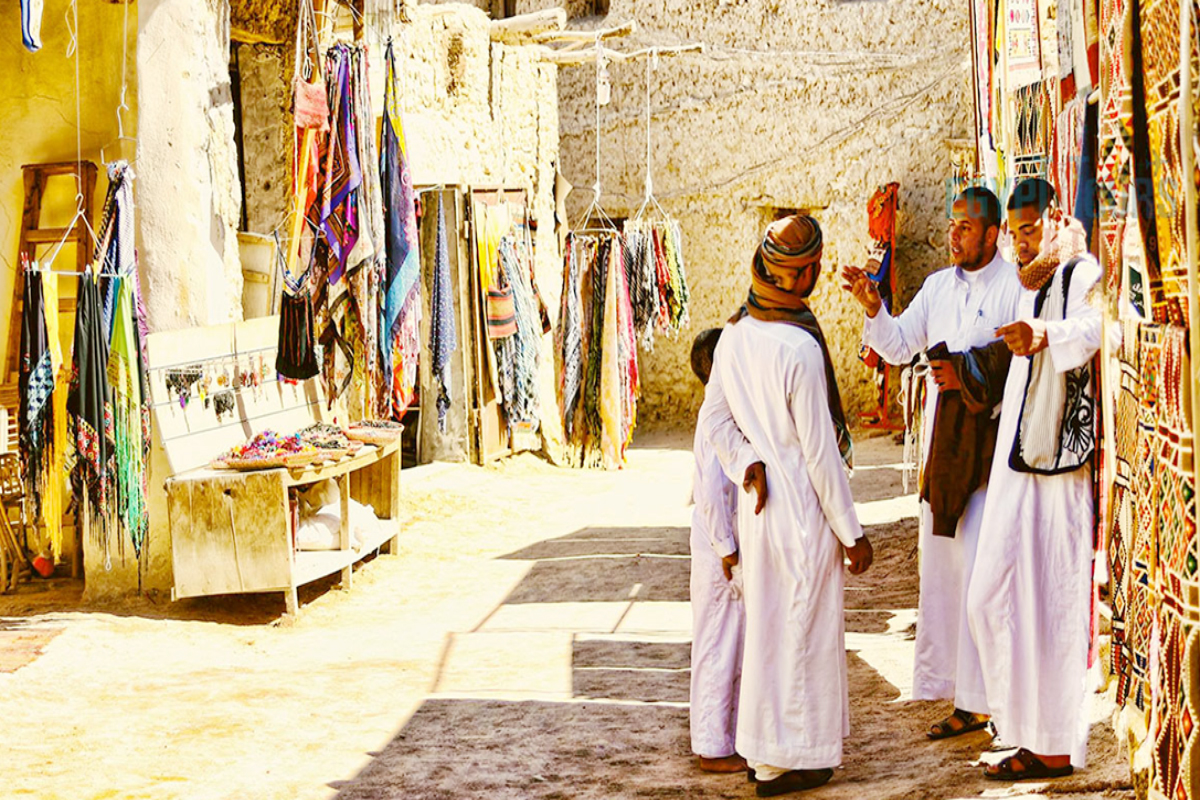
Siwa Oasis is home to about 25,000 to 30,000 inhabitants, primarily Siwi Berbers who speak the Siwi language, a Berber dialect. This language, along with Arabic, forms an important part of Siwan's identity, helping to maintain their unique cultural heritage.
Siwa’s population has historically remained isolated due to its remote location in the Western Desert, but the construction of a road in the 1980s has increased interaction with the outside world. In addition to Siwi Berbers, there is a small Bedouin community, mainly involved in trade and desert tourism. The oasis remains a culturally distinct area of Egypt, with strong ties to Berber traditions and customs.

Siwa Oasis is situated in a geological depression that reaches about 19 meters (62 feet) below sea level. This depression contributes to the natural springs that provide fresh water to the area, allowing for agricultural activities in an otherwise dry desert environment.
The nearby Qattara Depression, a larger feature of the Western Desert, drops even further, reaching 133 meters below sea level, making it the second-lowest point in Africa. Siwa’s unique location and geology have played a vital role in its survival as an oasis for thousands of years.

Siwa Oasis is generally considered a safe destination for tourists. It is a peaceful and welcoming community where tourism plays an important role in the local economy. However, as with any remote area, it’s advisable to travel with a reputable guide or tour operator, especially if you plan to explore the desert or the areas near the Egypt-Libya border.
While the oasis itself is well-protected, it is essential to follow any travel advisories and maintain normal safety precautions. Travelers should also be aware that Siwa is a conservative area, so respecting local customs and traditions helps ensure a positive experience.

Water is a key feature of Siwa Oasis, with over 200 natural springs and several large salt lakes. These springs, fed by artesian wells, support the oasis’s agriculture and have been essential to the local community for centuries.
One of the most famous water sources is Cleopatra’s Bath, a hot spring that has become a popular attraction for visitors. Siwa’s two main salt lakes, Birket Siwa and Birket Zeitun, also play an important role, not only in agriculture but also in attracting visitors interested in their therapeutic properties due to their high salt content. These lakes are vital to the oasis’s ecosystem and provide a unique aspect of Siwa’s geography.

The climate in Siwa Oasis is classified as a hot desert with extremely hot summers and mild winters. From May to September, temperatures can soar above 40°C (104°F), making it challenging to explore during the day.
Winter, from December to February, offers cooler temperatures, ranging from 15°C to 25°C (59°F to 77°F) during the day and dropping significantly at night. Rainfall is scarce, with Siwa receiving only about 9 mm of precipitation per year, mostly during the winter months. The oasis experiences intense sunshine throughout the year, with an average of 3,540 hours of sunshine annually.

Siwan architecture is unique and deeply tied to the natural environment. Traditional buildings in Siwa are constructed from kershif, a mixture of salt, mud, and palm wood, which has been used for centuries.
The most iconic structure is the Shali Fortress, built in the 13th century to protect the town. Although much of it was damaged by rain in 1926, the fortress remains a symbol of Siwa’s heritage and is illuminated at night, offering a striking view. Modern buildings have incorporated more contemporary materials like cement, but the traditional style remains prevalent, especially in eco-lodges and restored historical structures.
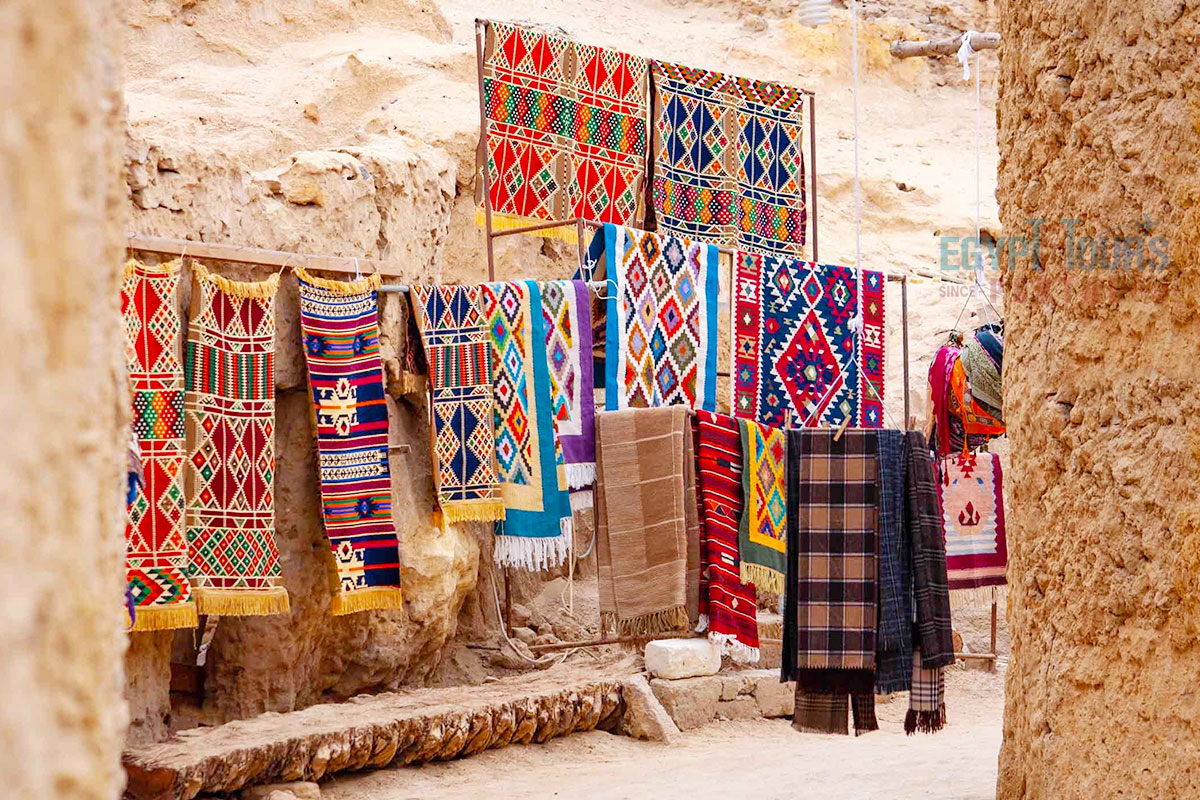
The culture of Siwa Oasis is rich in Berber traditions, with the Siwi language and Arabic being spoken by most of the population. Siwan society is rooted in communal values, and their annual Siyaha Festival celebrates reconciliation, unity, and the traditional patron saint, Sidi Sulayman.
Crafts such as silver jewelry, embroidery, and pottery are integral to Siwan culture, and many items bear Berber symbols believed to bring good health and fertility. The oasis’s isolation until recent decades has preserved much of its cultural identity, with traditional clothing, music, and food playing important roles in daily life and celebrations.
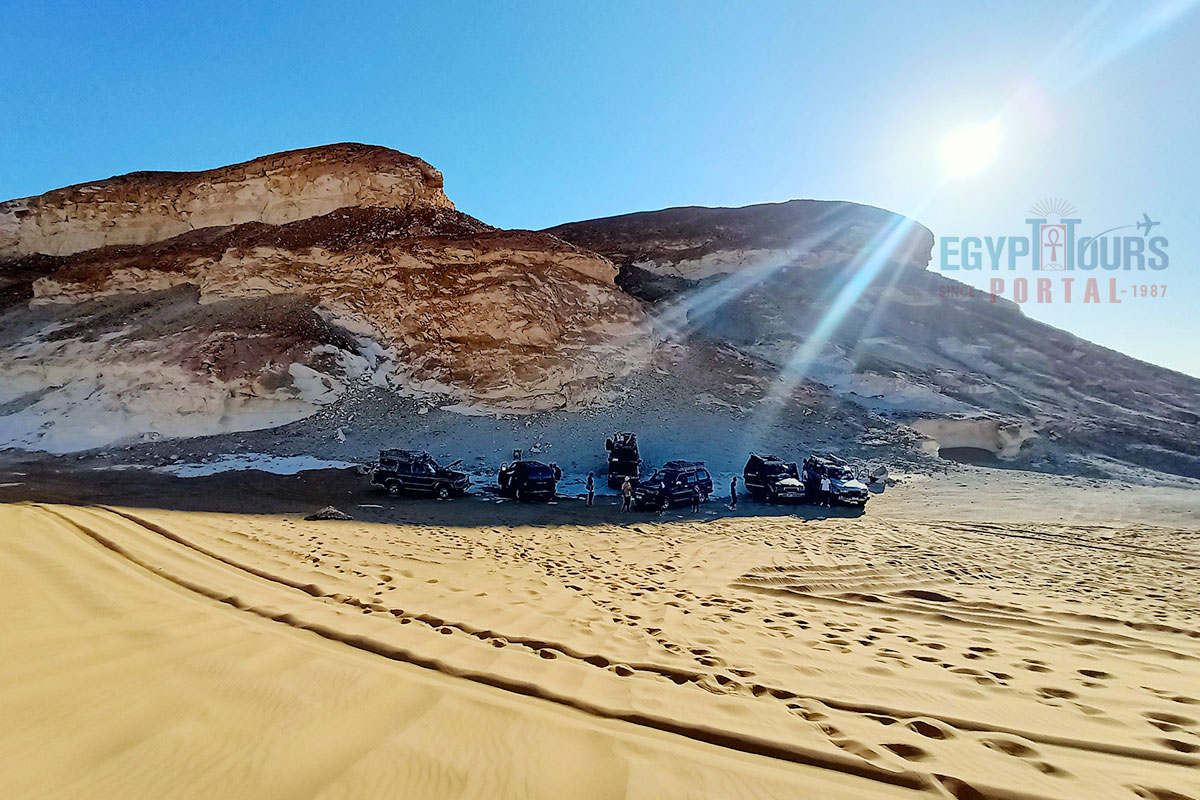
Camping in Egypt is one of the most popular activities in Siwa Oasis, offering a way to connect with the stunning desert landscape. Everyone can camp in the Great Sand Sea, where activities like sandboarding, camel trekking, and stargazing make for unforgettable experiences. Many tour operators offer camping trips that include overnight stays in Bedouin-style tents, complete with traditional meals and entertainment.
For a more serene experience, camping near Siwa’s salt lakes offers quiet and beautiful views, with the reflective waters providing a peaceful setting at sunrise and sunset. Camping is a great way to explore Siwa’s natural beauty and experience its desert environment.

Shopping in Siwa is a unique experience with a very special culture, offering visitors a chance to purchase traditional Siwan crafts, such as silver jewelry, embroidered textiles, baskets, and pottery.
These items are handmade by local artisans and often feature designs that reflect the Berber heritage of the region. Siwa is also famous for its dates and olive oil, both of which are high-quality products that make for excellent souvenirs. The local market in Siwa is small but filled with authentic, handcrafted goods, where visitors can engage with locals and take home a piece of Siwa’s rich culture.

Siwa’s geological formation is characterized by Miocene-era limestone, which forms the foundation of the oasis’s unique landscape. The oasis sits in a natural depression, surrounded by inselbergs, which are isolated rock hills that rise from the flat desert floor. Erosion over thousands of years has created these striking geological features.
Siwa is also part of the Libyan Desert plateau, and the nearby Qattara Depression contributes to the area’s unique geography. The natural springs and salt lakes are a direct result of the oasis’s location in this depression, where underground water sources rise to the surface.

Siwa has a variety of small restaurants offering local and traditional Egyptian cuisine. Many restaurants serve dishes featuring dates, olives, and other local produce, with meals often prepared in a simple but flavorful way.
Some of the most rated hotels in this magical oasis are OLA restaurant, Abdu Restaurant, Muhra Restaurant, Tekeyet Elamir Restaurant & Café, and more awesome locations. Popular dishes include fattah, a dish made of rice, toasted bread, and meat, and agroz, the heart of palm. Some of the most frequented places include Abdu’s Restaurant and Kenooz, where travelers can enjoy a taste of Siwan hospitality.

The Best time to visit Egypt and, of course, Siwa Oasis is from October to April, when temperatures are mild and comfortable for exploration. During this period, daytime temperatures range from 15°C to 25°C (59°F to 77°F), making it perfect for outdoor activities like visiting the ancient Oracle of Amun, swimming in natural springs, or off-roading in the Great Sand Sea.
The summer months, from May to September, are much hotter, with temperatures often exceeding 40°C (104°F), which can make outdoor exploration difficult. Winter offers cool days and chilly nights, while spring and autumn present pleasant weather ideal for desert camping and cultural experiences like the Siyaha Festival. This October festival is a major event that celebrates local traditions and reconciliation among the Siwan people.
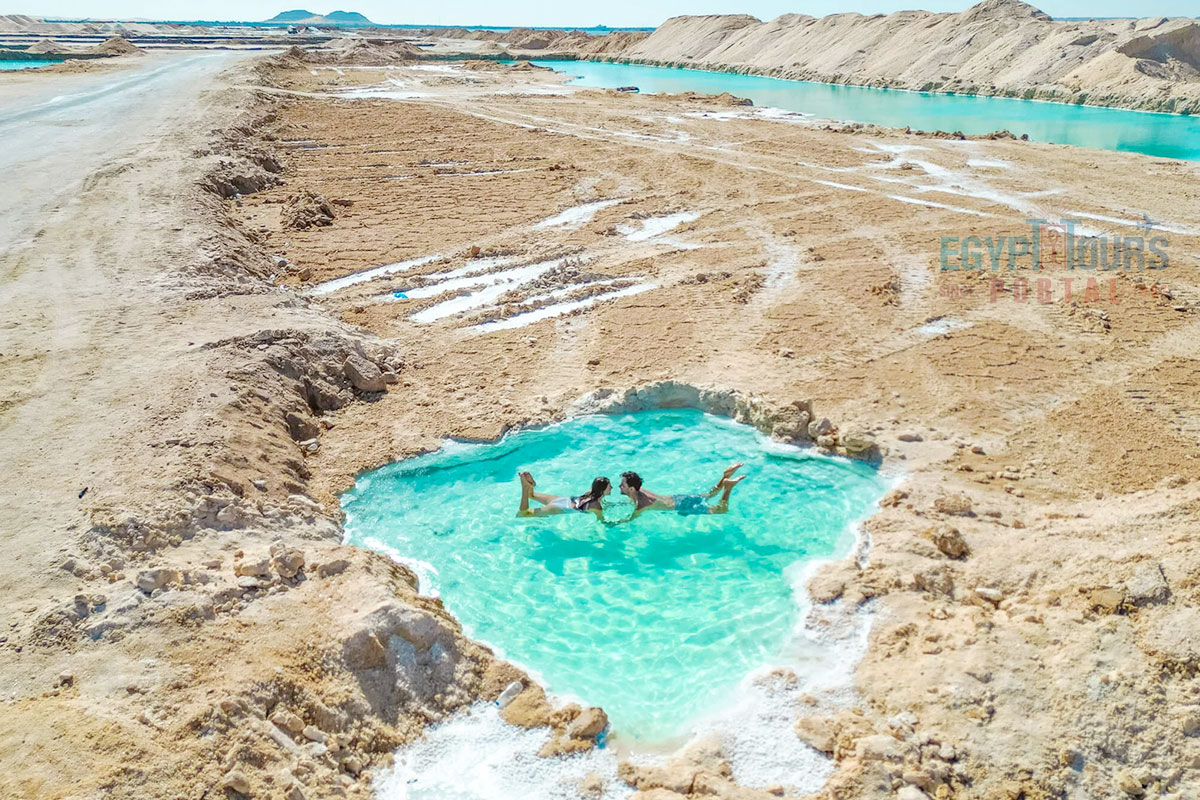
Siwa is a conservative community where modest dress is encouraged, especially for women. Female visitors should respect local customs by wearing loose-fitting clothing that covers the shoulders, arms, and legs. Long skirts, pants, and blouses with sleeves are suitable for exploring the town and visiting historical sites.
While a headscarf is not obligatory for tourists, it can be useful to carry one for visiting religious or culturally significant areas. In hotels or private resorts, it’s acceptable to wear swimsuits, but modesty should still be observed when moving between areas. Dressing conservatively not only shows respect for local customs but also helps visitors feel more comfortable in this traditional society.
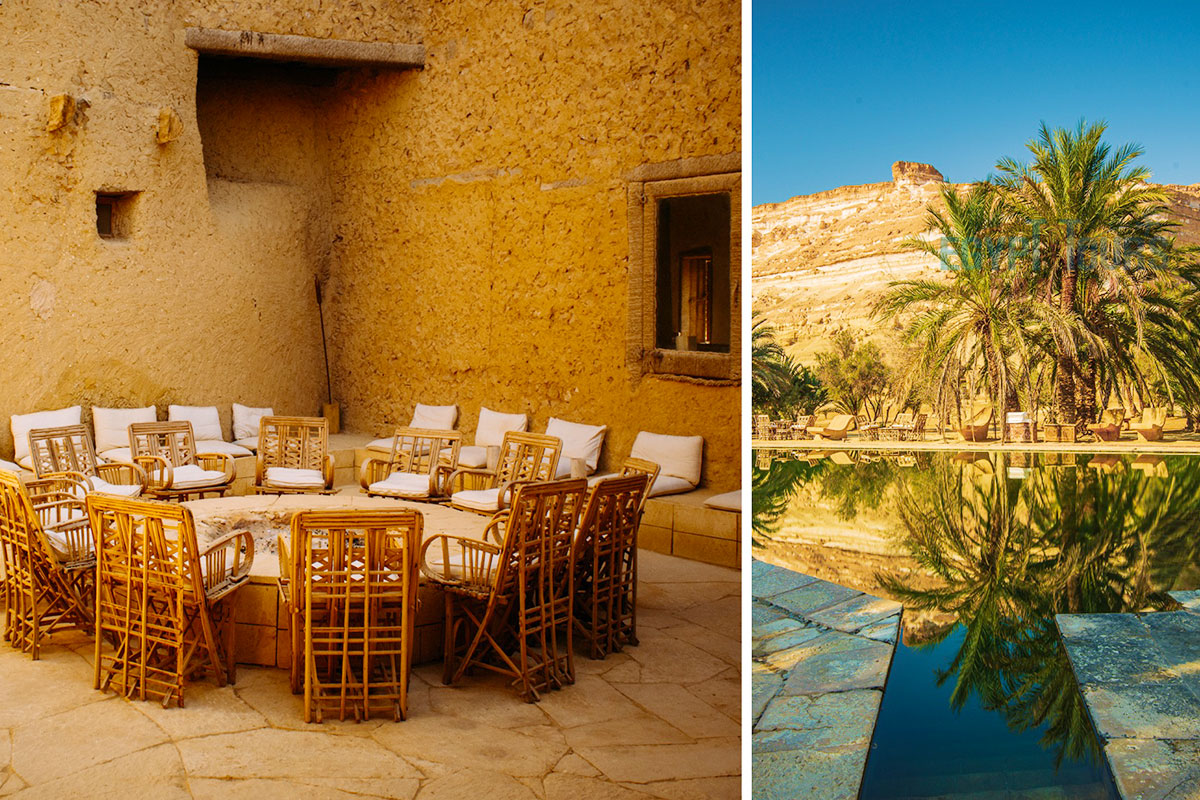
Siwa offers a variety of accommodations, ranging from eco-lodges to more modern hotels. Many of the eco-lodges in Siwa, such as Adrère Amellal and Shali Lodge, are built using traditional materials like kershif (a mixture of salt, mud, and palm wood), blending harmoniously with the natural landscape.
These hotels, which include Tijan Siwa, Seliyaa Hotel, Taghaghien Island Resort Siwa, and Cafour House Siwa, focus on sustainability and often operate with minimal electricity, relying on candlelight to enhance the desert experience. Another option is Taziry Ecolodge offers a remote and serene atmosphere, with no modern amenities, providing a true retreat into nature. Most Siwa hotels emphasize eco-friendly principles and traditional aesthetics, offering guests a unique experience that mirrors the beauty and simplicity of the oasis.
The Siwa oasis is one of the places that can't be missed, so check all our Siwa tours and witness this marvelous Hub. You will get to feel the allure and bliss of the ancient Egyptian culture and life when you discover all the historical artifacts in the immortal cities of Cairo, Alexandria, Luxor, and Aswan through our bespoke Egypt tours and magical Nile River cruise.
Private 4 Days Cairo Tour Packages for American Travelers 4 days Cairo Egypt Tour pa...
Tour Location: Cairo – Giza...
5 Days Cairo and Alexandria Tour Package For American Travelers 5 days Cairo and Ale...
Tour Location: Cairo/Giza/Alexandria...
6 Days Cairo, Luxor & Aswan Tour Package For American Travelers 6 days Cairo, Lu...
Tour Location: Cairo/Giza/Aswan/Luxor...
Amazing 7 Days Cairo and Hurghada Holiday for American Travelers 7 Days Cairo & ...
Tour Location: Cairo – Giza – Hurgh...
Siwa is a famous stop throughout history for travelers, pilgrims, and nomads which provided them with an abundant water supply, food, and shelter. They lived here since the 29th century BC according to historical records. This oasis is most famous for producing various types of fruits, dates, olives, and more.
The most known part in Siwa was is the Temple of the Oracle that dates from the 6th century BC and was renowned throughout the Mediterranean world. The magical eco-system and natural lakes is a popular attraction among travelers
Siwa is located on an isolated oasis situated in the Western Desert region of Egypt, 550 km west of the capital Cairo, 305 km south-west of Marsa Matruh and some 50 km from the border with Libya. Siwa has a long history dating back to 525 BC as Siwa's ancient Egyptian name was Sekht-am, meaning “palm land.” and was extremely popular during the Greco-Roman period.
You can drive, by going all the way to Marsa Matrouh; then head south in the direction of Siwa for a duration of approximately 3 hours.
In the mid-20th century, Egyptian archaeologist Ahmed Fakhry worked at Siwa and In 1995, Greek archaeologist Liana Souvaltzi announced that she had identified one alleged tomb in Siwa with evidence of the presence of Alexander the Great.
Siwa Oasis is very safe despite its far distance as it is very secure and under the protection of the Egyptian government due to the importance of the attraction. Every traveler will enjoy the natural delights of Siwa Oasis under a safe and relaxing atmosphere.
Siwa Oasis is one of Egypt's most isolated settlements filled with about 33,000 people, mostly Berbers, who developed a unique and isolated desert culture and a language called Siwi.
Siwa was built in 1203 to house the 40 survivors of a tribal attack on the nearby settlement of Aghurmi, this walled, hilltop town protected the entire Siwan population for centuries.
Everyone can swim in natural springs which are found 300 southwest of the Meditteranean town Marsa Matrouh and is below sea level offering a number of marvelous natural landscapes.
The oasis is 6 miles (10 km) long by 4–5 miles (6–8 km) wide and has about 200 springs filled with natural water with high levels of salt. There are two rock outcrops that provide the sites of the old walled settlements of Siwa and Aghūrmī, which are veritable fortresses.
Siwa Oasis is famous for its unique Berber culture, stunning desert landscapes, and ancient historical sites. The oasis is home to the Temple of the Oracle of Amun, a sacred place where ancient Egyptians consulted the god Amun. Siwa is known for its mudbrick architecture, hot springs, and the annual Siwa Festival, a celebration of local culture and traditions.
Yes, you can swim in Siwa Oasis. There are several swimming pools and natural hot springs available for visitors. Additionally, some of the local lakes are suitable for swimming.
The primary language spoken in Siwa Oasis is Siwi, a Berber language. However, many locals also speak Arabic.
Siwa Oasis is not salty. The water in the oasis is generally fresh and suitable for drinking.
The majority of the people in Siwa Oasis follow Islam. However, there is also a small minority of Christians, particularly among the Coptic population.
Siwa is a small oasis town located in the western desert of Egypt.
The entire country of Egypt deserve to be explored with its every heavenly detail but there are places that must be seen before any other such as the breathtaking Hurghada's red sea, The wonders of Cairo the pyramids of Giza, the great sphinx, the Egyptian Museum, Khan El Khalili Bazaar, the wonders of Luxor like Valley of the Kings, Karnak & Hatshepsut temple and the wonders of Aswan such as Abu Simbel temples, Philea temple, Unfinished obelisk and The Wonders of Alexandria like Qaitbat Citadel, Pompey's Pillar and Alexandria Library. Read more about the best places to visit in Egypt.
If you want to apply for a Visa On Arrival that lasts for 30 days then you should be one of the eligible countries, have a valid passport with at least 6 months remaining and pay 25$ USD in cash, as for the E-Visa for 30 day you should have a valid passport for at least 8 months, complete the online application, pay the e-visa fee then print the e-visa to later be presented to the airport border guard. You could also be one of the lucky ones who can obtain a free visa for 90 days. Read more about Egypt travel visa.
Egypt has a variety of delicious cuisines but we recommend “Ful & Ta’meya (Fava Beans and Falafel)”, Mulukhiya, “Koshary”, a traditional Egyptian pasta dish, and Kebab & Kofta, the Egyptian traditional meat dish.
The best time to travel to Egypt is during the winter from September to April as the climate becomes a little tropical accompanied by a magical atmosphere of warm weather with a winter breeze. You will be notified in the week of your trip if the Climate is unsafe and if any changes have been made.
You should pack everything you could ever need in a small bag so you could move easily between your destinations.
We have been creating the finest vacations for more than 20 years around the most majestic destinations in Egypt. Our staff consists of the best operators, guides and drivers who dedicate all of their time & effort to make you have the perfect vacation. All of our tours are customized by Travel, Financial & Time consultants to fit your every possible need during your vacation. It doesn't go without saying that your safety and comfort are our main priority and all of our resources will be directed to provide the finest atmosphere until you return home.
You will feel safe in Egypt as the current atmosphere of the country is quite peaceful after the government took powerful measures like restructuring the entire tourist police to include all the important and tourist attractions in Egypt. Read more about is it safe to travel to Egypt.
Wear whatever feels right and comfortable. It is advised to wear something light and comfortable footwear like a closed-toe shoe to sustain the terrain of Egypt. Put on sun block during your time in Egypt in the summer to protect yourself from the sun.
The best activity is by far boarding a Nile Cruise between Luxor and Aswan or Vise Versa. Witness the beauty of Egypt from a hot balloon or a plane and try all the delicious Egyptian cuisines and drinks plus shopping in old Cairo. Explore the allure and wonders of the red sea in the magical city resorts of Egypt like Hurghada and many more by diving and snorkeling in the marine life or Hurghada. Behold the mesmerizing western desert by a safari trip under the heavenly Egyptian skies.
There are a lot of public holidays in Egypt too many to count either religious or nation, the most important festivals are the holy month of Ramadan which ends with Eid Al Fitr, Christmas and new years eve. Read more about festivals & publich holidays in Egypt.
Egypt is considered to be one of the most liberal Islamic countries but it has become a little bit conservative in the last couple of decades so it is advised to avoid showing your chest, shoulders or legs below the knees.
Arabic is the official language and Most Egyptians, who live in the cities, speak or understand English or at least some English words or phrases. Fewer Egyptians can speak French, Italian, Spanish, and German. Professional tour guides, who work in the tourism sector, are equipped to handle visitors who cannot speak Arabic and they will speak enough English and other languages to fulfill the needs of all our clients.
The fastest way is a car, of course, a taxi. If you are in Cairo ride a white taxi to move faster or you could board the fastest way of transportation in Egypt metro if the roads are in rush hour.
The temperature in Egypt ranges from 37c to 14 c. Summer in Egypt is somehow hot but sometimes it becomes cold at night and winter is cool and mild. The average of low temperatures vary from 9.5 °C in the wintertime to 23 °C in the summertime and the average high temperatures vary from 17 °C in the wintertime to 32 °C in the summertime. The temperature is moderate all along the coasts.
It is the home of everything a traveler might be looking for from amazing historical sites dating to more than 4000 years to enchanting city resorts & beaches. You will live the vacation you deserve as Egypt has everything you could possibly imagine.









